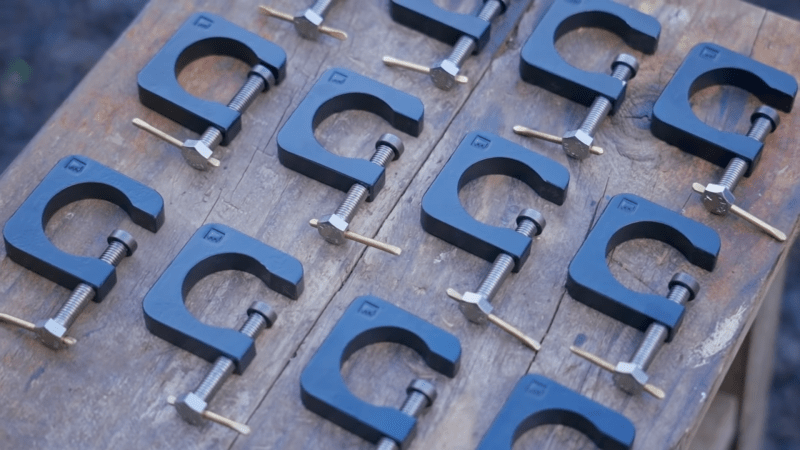Sometimes you need a small clamp, and sometimes it’s nice to use tools you’ve made yourself. [Neil] from [Pask Makes] delivers on both counts, with incredibly cute little clamps that he whipped up in his own home shop. You can even make them with hand tools!
The first step is to cut out a section of flat steel bar, and then drill a hole in the middle. The flats that form the key clamping surfaces can then be cut using a hacksaw. From there, it’s a matter of cleaning up the resulting blank with a file to take off sharp edges and neaten up the flats.
Drilling and tapping the main hole through the bottom of the clamp is the next job, and getting the hole straight and true is key to making a good usable clamp. The video shares tips on how to do this with even a simple cordless drill, by using a vice and a wood guide to keep things on track. The swiveling nut is then made out of a piece of round bar, and installed on the end of a bolt to create a nice clamping surface. A cute little brass handle is used to tighten it up.
It’s a useful tool, and the video goes on to show how the clamp can be made more quickly using higher-end facilities. While small clamps can be had cheaply, the video notes that making tools is fun and we think that’s as good a reason as any to make your own.
We’ve seen [Neil]’s work before, particularly in the case of this stunning “bladeless fan” build. Video after the break.
















*vise
Vice (noun) – a metal tool with movable jaws which are used to hold an object firmly in place while work is done on it, typically attached to a workbench.
Vice is the correct spelling here in the UK
Kinda funny coming from the people who spell the word “practice” as “practise”
Wrong, most of the world spell the noun “practice” that way, and the verb as “practise”…
🗜️
:o)
I’ve seen it spelled “vyce” in older vooks here in .au.
The correct spelling depends on where in the world you live.
Just wait till you hear a British person says pry.
eg:
Prise…To force or open with a lever.
I think you are mixing up two different words
Awkwardly, they are or were called “cramps” in Australia, depending on who you asked. In “Shop A” (woodworking class) it was “cramp” twenty odd years ago. I doubt they’re called that in a Bunnings today though.
Some still are in the UK. Bar clamps are often called “sash cramps”. Unless they are called “sash clamps”.
I think that a clamp becomes a cramp when it clamps wood :-)
If you’re working with hand tools, a good way to get a hole started right is to drill a short pilot hole with a much smaller bit. The smaller drill doesn’t wander off as easily, so you can start the hole exactly where you want it and the bigger drill will follow the pilot hole until it’s deep enough to form walls around itself.
Even if you didn’t get the small hole exactly dead center, you can then open it up a little more towards the middle and it’ll still work – unlike with the big drill where you have only one shot to get it right, and it never goes there.
I’ve always had good luck w/ a few hard smacks from a center punch, but YMMV.
If you look at a typical metal drill bit, it doesn’t have a sharp point, it has a flat ridge at the tip like a chisel that merely pushes the metal around instead of cutting it.
The tip of a larger drill bit is too large to fit in the divot left behind by a center punch. When you push the drill bit to the punched hole, it’s going to catch one end of the ridge first like you were trying to drill the hole with a flat head screwdriver, which will basically mangle it up and start the hole on a random location close by.
It all depends on what is your definition of “close enough”. When you’re drilling a hole for an M8 bolt into a 10 mm thick bar, going half a millimeter out means it’s going to show because the wall thicknesses left behind are less than 2 mm each side, so you really need to hit that center. It’s perfectly easy even with a plain old hand cranked drill, but you have to start the hole right.
Or use a center drill. That’s what they’re for, after all.
Technically a centre drill is for making a hole for a lathe centre.
The tool that is specifically intended for starting / locating a hole is a “Spotting drill”
But centre drills work well in the role too.
Righto, there.
https://neill-lavielle.com/louisville-cutting-tools-centerdrills/
“Centerdrills Don’t Center Drills”
A center drill still has the same chisel tip problem as I mentioned above, so you still need to use a smaller bit before you use the larger bit when drilling with hand tools. You don’t need to put a hole right through – just make a start for it.
A regular small drill bit will make the pilot hole just fine, while a spotting drill will do it better because it has a very fine sharp point and it opens the hole up to a wider angle that actually guides the big drill bit towards the middle.
A pin vise and a 1-2 mm bit is your friend. Couple twists with your fingers opens up the punch mark wide enough that the larger drill bit will sit right.